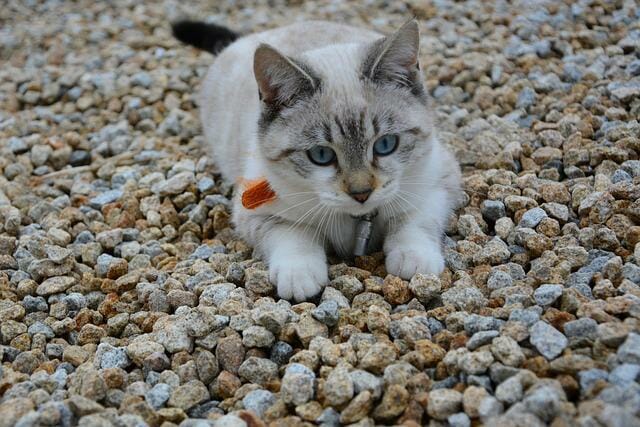How to Check Cat for Fleas: Ways to Tell if Your Cat Has Fleas and How
You must look for flea activity signs to check your cat for fleas. Fleas are tiny, but you can see them with the naked eye. Look for small brown or black insects on your cat’s skin, particularly in areas with thin fur around the ears, under the chin, and belly.
You may also use a flea comb which is a special comb with very fine teeth that can remove fleas and their eggs from your cat’s fur. Comb through your cat’s fur, paying special attention to the base of the tail, neck, and behind the ears. If you find fleas or flea dirt on your cat, it’s important to treat them promptly to prevent an infestation. Consult with your veterinarian for the best treatment options for your cat.


Table of Contents
Ways to Tell if Your Cat Has Fleas
Look for Signs of Flea Activity
When looking for signs of flea activity in cats, it’s important to remember that fleas are very small and can be difficult to spot. Start by parting your cat’s fur, especially in areas where it’s thin, such as the neck, behind the ears, and along the belly. Use your fingers to separate the fur, exposing the skin underneath gently.
Fleas are fast-moving insects, and you may see them scurrying across your cat’s skin. Look for tiny brown or black insects about the size of a pinhead. They may be easier to see if you hold your cat in a well-lit area. Fleas bite animals to feed on their blood, and their bites can cause itching, redness, and swelling. Look for small red bumps or scabs on your cat’s skin, especially around the head, neck, and tail.
Look for Flea Dirt
Flea dirt, also known as flea feces or flea frass, is the excrement of fleas that contain partially digested blood and is a common sign of flea infestation in cats. Flea dirt is usually small, dark, and granular, similar to ground black pepper or coffee grounds.
Before looking for flea dirt, brush the cat’s coat with a fine-toothed comb to remove any loose hair and debris. This will make it easier to see any signs of flea dirt. Use a comb to part the cat’s hair and examine the skin, especially in areas where fleas are known to hide, such as the base of the tail, the groin, and behind the ears.
Look for small black or brown granules that resemble black pepper or coffee grounds. Flea dirt may also appear as small reddish-brown specks on light-colored fur. Once you have found what you suspect is flea dirt, place a small amount of it on a damp paper towel or white tissue paper. If it turns reddish-brown when moistened, it is likely flea dirt, as the digested blood in the feces will dissolve and spread on the paper.
Observe Your Cat’s Behavior


Fleas can cause discomfort and irritation in cats, leading to specific behaviors that indicate their presence. For example, cats with flea infestations often scratch or groom themselves excessively, trying to relieve the itchiness and discomfort caused by the fleas. Pay attention to your cat’s grooming behavior and look for areas of redness, scabs, or hair loss, which can be caused by excessive scratching.
Flea bites can cause cats to become restless, agitated, or irritable. If your cat seems constantly moving or twitching, it could signify flea infestation. In severe cases, flea infestations can cause cats to lose their appetite, become lethargic, and show signs of weakness. If your cat is not eating or seems unusually tired, it could indicate a more severe flea infestation.
Fleas tend to congregate in specific areas of a cat’s body, such as around the base of the tail, on the neck, or behind the ears. It could signify flea activity if you notice your cat grooming excessively in one area. In addition, fleas can bite humans, leaving itchy, red bumps on the skin. If fleas have bitten you or anyone in your household, it could signify a flea infestation in your cat.
Use a Flea Comb
Flea combs are useful for detecting and removing fleas and flea dirt from your cat’s fur. Look for a flea comb with fine teeth that are close together, as this will allow you to remove fleas and flea dirt more easily. You can find flea combs at most pet supply stores.
Before you start combing:
- Make sure your cat is comfortable and relaxed.
- Please treat or play with them for a few minutes to help them settle down.
- Begin combing your cat’s fur, starting at the head and working your way down to the tail.
- Use the flea comb to separate the fur and expose the skin underneath.
- Be gentle but firm, and avoid pulling on your cat’s skin.
You may see fleas or flea dirt on the comb as you comb. Use a tissue or paper towel to wipe them off the comb and dispose of them immediately. You can also dip the comb in a bowl of soapy water to help kill any fleas you’ve removed.
Continue combing your cat’s fur until you’ve covered its entire body. Be sure to focus on areas where fleas are most likely to hide, such as the base of the tail, neck, and behind the ears.
You may need to comb your cat several times over a few days to remove all the fleas. Once you’ve finished combing, wash your hands and clean the area where you combed your cat. Dispose of any tissue or paper towel you used to remove fleas or flea dirt.
How to Deal With Flea Infestation in Cats


Dealing with a flea infestation in cats requires a comprehensive approach that includes treating the cat and its environment. If you suspect your cat has fleas, it’s important to consult with your veterinarian to get a proper diagnosis and treatment plan. Your veterinarian can recommend the best flea treatment for your cat, depending on age, weight, and overall health.
Various flea treatments are available for cats, including topical treatments, oral medications, and flea collars. Your veterinarian can recommend the best treatment option for your cat based on its needs. Follow the treatment instructions carefully, and treat all cats in your household.
Fleas can survive in your cat’s environment, such as bedding, carpets, and furniture. Treating your cat’s environment to eliminate fleas and prevent re-infestation is essential. You can use flea sprays, powders, or foggers in your home, but follow the instructions carefully and keep your cat away from the treated area until it’s safe.
Vacuuming your home regularly can help remove flea eggs, larvae, and pupae from carpets, furniture, and other surfaces. Please pay particular attention to areas where your cat spends time, such as its bedding and favorite resting spots. Be sure to dispose of the vacuum bag or contents immediately after vacuuming.
Washing your cat’s bedding, toys, and other washable items in hot water can also help kill any fleas or flea eggs that may be present. In addition, regular flea prevention is key to preventing future infestations. In addition, your veterinarian can recommend the best flea prevention products for your cat, such as monthly topical treatments or oral medications.
